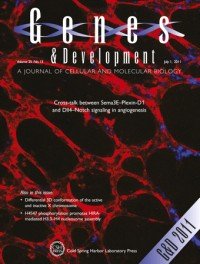Genes and Development Q1 Unclaimed
Genes & Development publishes high-quality research papers of broad general interest and biological significance in the areas of molecular biology, molecular genetics, and related fields. In addition to Review Articles and Perspectives, Genes & Development publishes three research formats—Research papers, short Research Communications, and Resource/Methodology papers. Genes & Development has been named one of the Top Five Research Journals in the field of Molecular Biology and Genetics It has an SJR impact factor of 4,005.
Genes and Development focuses its scope in these topics and keywords: signaling, nuclear, required, transcription, dna, cell, complex, development, drosophila, factor, ...
Type: Journal
Type of Copyright:
Languages: English
Open Access Policy: Open Access
Type of publications:
Publication frecuency: -


2312 €
Inmediate OA0 €
Embargoed OA- €
Non OAMetrics
4,005
SJR Impact factor489
H Index75
Total Docs (Last Year)306
Total Docs (3 years)5712
Total Refs1922
Total Cites (3 years)293
Citable Docs (3 years)4.89
Cites/Doc (2 years)76.16
Ref/DocOther journals with similar parameters
Annual Review of Cell and Developmental Biology Q1
Developmental Cell Q1
Translation Q1
International Journal of Biological Sciences Q1
Seminars in Cell and Developmental Biology Q1
Compare this journals
Aims and Scope
Best articles by citations
Molecular mechanisms of ribosomal protein gene coregulation
View moreThe activity of the Nodal antagonist Cerl-2 in the mouse node is required for correct L/R body axis
View moreAdaptor protein Ste50p links the Ste11p MEKK to the HOG pathway through plasma membrane association
View moreHuman intron-encoded Alu RNAs are processed and packaged into Wdr79-associated nucleoplasmic box H/ACA RNPs
View moreThe cellular roles of the lissencephaly gene LIS1, and what they tell us about brain development
View moreThe FLP proteins act as regulators of chlorophyll synthesis in response to light and plastid signals in Chlamydomonas
View moreGIGYF1/2 proteins use auxiliary sequences to selectively bind to 4EHP and repress target mRNA expression
View moreThe Drosophila cell cycle kinase PAN GU forms an active complex with PLUTONIUM and GNU to regulate embryonic divisions
View moreLoss of RBF1 changes glutamine catabolism
View moreThe PAS/LOV protein VIVID supports a rapidly dampened daytime oscillator that facilitates entrainment of the Neurospora circadian clock
View moreThe nuclear matrix protein CIZ1 facilitates localization of Xist RNA to the inactive X-chromosome territory
View moreA spatial gradient of expression of a cAMP-regulated prespore cell-type-specific gene in Dictyostelium.
View moreThe GATA-type transcription factors GNC and GNL/CGA1 repress gibberellin signaling downstream from DELLA proteins and PHYTOCHROME-INTERACTING FACTORS
View moreActivation of Wnt signaling bypasses the requirement for RTK/Ras signaling during C. elegans vulval induction
View moreThe homeodomain protein Vax1 is required for axon guidance and major tract formation in the developing forebrain
View moreRhoB controls Akt trafficking and stage-specific survival of endothelial cells during vascular development
View moreCdk1-Clb4 controls the interaction of astral microtubule plus ends with subdomains of the daughter cell cortex
View moreEcsit is required for Bmp signaling and mesoderm formation during mouse embryogenesis
View moreEcsit-ement on the crossroads of Toll and BMP signal transduction
View moreNegative regulation of calcineurin signaling by Hrr25p, a yeast homolog of casein kinase I
View moreBrachyury proteins regulate target genes through modular binding sites in a cooperative fashion
View moreRecruitment of sphingosine kinase to presynaptic terminals by a conserved muscarinic signaling pathway promotes neurotransmitter release
View moreGetting the right dose of repression
View moreThe PDGF signaling pathway controls multiple steroid-producing lineages
View more
Comments